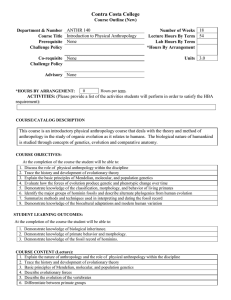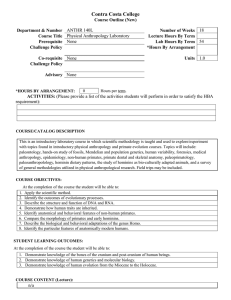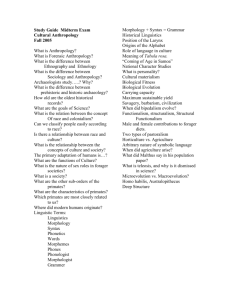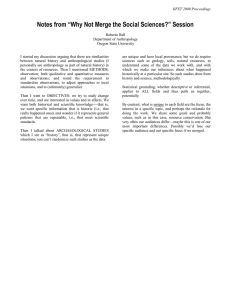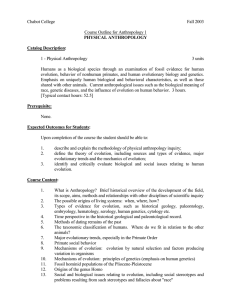ANTHR 140-S14.doc 73KB Sep 04 2014 04:17:33 PM
advertisement
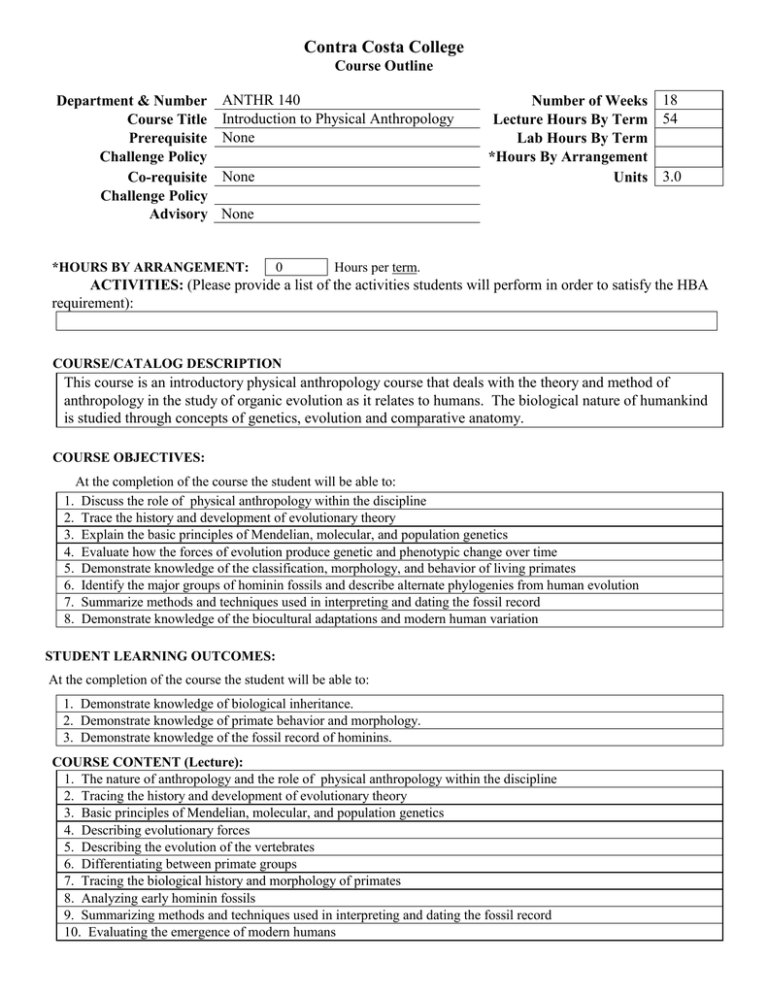
Contra Costa College Course Outline Department & Number Course Title Prerequisite Challenge Policy Co-requisite Challenge Policy Advisory ANTHR 140 Introduction to Physical Anthropology None None Number of Weeks 18 Lecture Hours By Term 54 Lab Hours By Term *Hours By Arrangement Units 3.0 None *HOURS BY ARRANGEMENT: 0 Hours per term. ACTIVITIES: (Please provide a list of the activities students will perform in order to satisfy the HBA requirement): COURSE/CATALOG DESCRIPTION This course is an introductory physical anthropology course that deals with the theory and method of anthropology in the study of organic evolution as it relates to humans. The biological nature of humankind is studied through concepts of genetics, evolution and comparative anatomy. COURSE OBJECTIVES: At the completion of the course the student will be able to: 1. Discuss the role of physical anthropology within the discipline 2. Trace the history and development of evolutionary theory 3. Explain the basic principles of Mendelian, molecular, and population genetics 4. Evaluate how the forces of evolution produce genetic and phenotypic change over time 5. Demonstrate knowledge of the classification, morphology, and behavior of living primates 6. Identify the major groups of hominin fossils and describe alternate phylogenies from human evolution 7. Summarize methods and techniques used in interpreting and dating the fossil record 8. Demonstrate knowledge of the biocultural adaptations and modern human variation STUDENT LEARNING OUTCOMES: At the completion of the course the student will be able to: 1. Demonstrate knowledge of biological inheritance. 2. Demonstrate knowledge of primate behavior and morphology. 3. Demonstrate knowledge of the fossil record of hominins. COURSE CONTENT (Lecture): 1. The nature of anthropology and the role of physical anthropology within the discipline 2. Tracing the history and development of evolutionary theory 3. Basic principles of Mendelian, molecular, and population genetics 4. Describing evolutionary forces 5. Describing the evolution of the vertebrates 6. Differentiating between primate groups 7. Tracing the biological history and morphology of primates 8. Analyzing early hominin fossils 9. Summarizing methods and techniques used in interpreting and dating the fossil record 10. Evaluating the emergence of modern humans COURSE CONTENT (Lab): METHODS OF INSTRUCTION: Lecture/Discussion Audio-Visual Cooperative Learning INSTRUCTIONAL MATERIALS: NOTE: To be UC/CSU transferable, the text must be dated within the last 7 years OR a statement of justification for a text beyond the last 7 years must be included. Textbook Title: Our Origins: Discovery Physical Anthropology Author: Clark Spencer Larsen Publisher: W. W. North and Company Edition/Date: 3rd edition, 2014 Textbook Reading Level: 21.3 grade level Justification Statement: OUTSIDE OF CLASS WEEKLY ASSIGNMENTS: Title 5, section 55002.5 establishes that a range of 48 -54hours of lecture, study, or lab work is required for one unit of credit. For each hour of lecture, students should be required to spend an additional two hours of study outside of class to earn one unit of credit. State mandates that sample assignments must be included on the Course Outline of Record. Outside of Class Weekly Assignments Hours per week Weekly Reading Assignments (Include detailed assignment below, if applicable) 3 Reading #1: Read the section in the textbook on Charles Darwin and the principles of evolution; discuss the development of the evolutionary theory of Darwin. Reading #2: Read the section on paleoanthropology and plio-pleistocene hominids, and discuss the adaptive radiation of Australopithecus during the Pliocene. Weekly Writing Assignments (Include detailed assignment below, if applicable) 3 Writing #1: Provide two alternative interpretations of the concept of race in American society. One model should focus on biological frameworks and the other should consider the matter from a social perspective. Writing #2: Read the section on primate behavior and outline problems which might be expected from the observer’s tendencies to anthropomorphize data regarding non-human primates. How might some of this observer bias subjectively be avoided? Weekly Math Problems (Include detailed assignment below, if applicable) Lab or Software Application Assignments (Include detailed assignment below, if applicable) Other Performance Assignments (Include detailed assignment below, if applicable) Field trip to the Oakland Zoo to evaluate primate behavior. 0.5 STUDENT EVALUATION: (Show percentage breakdown for evaluation instruments) 50 25 15 10 % % % % Midterm and Final Exam. Term Paper critically evaluating a topic in physical anthropology. Weekly homework exercises. Zoo Visit- one observation session of primates evaluating behavior. GRADING POLICY: (Choose LG, P/NP, or SC) x Letter Grade Pass / No Pass 90% - 100% = A 80% - 89% = B 70% and above = Pass Below 70% = No Pass 70% - 79% = C 60% - 69% = D Below 60% = F Prepared by: Manu Ampim Date: 4-18-14 Revised form 10/13 Student Choice 90% - 100% = A 80% - 89% = B 70% - 79% = C 60% - 69% = D Below 60% = F or 70% and above = Pass Below 70% = No Pass
